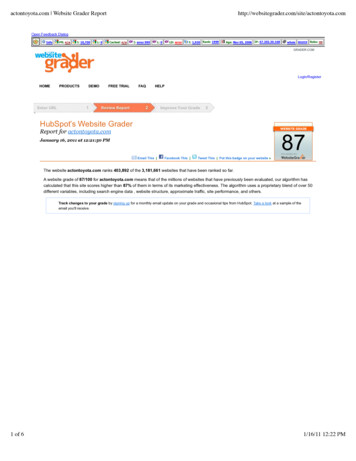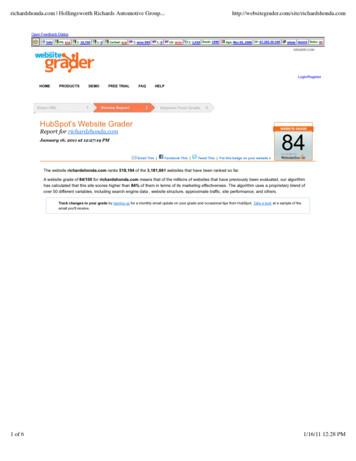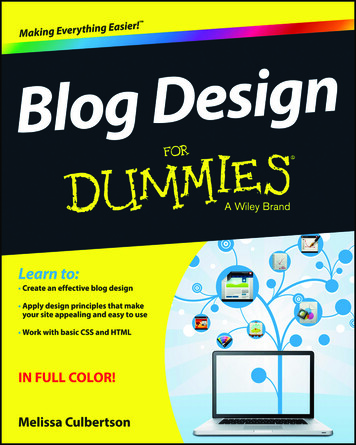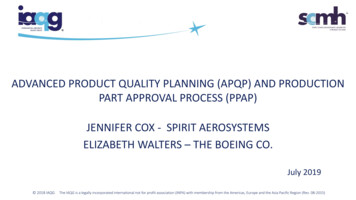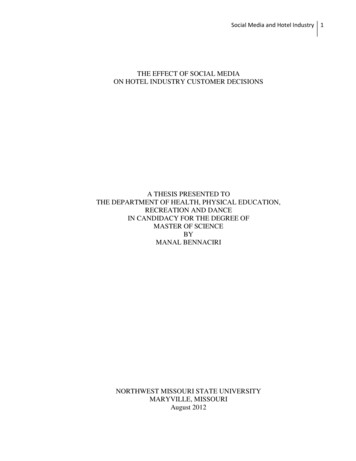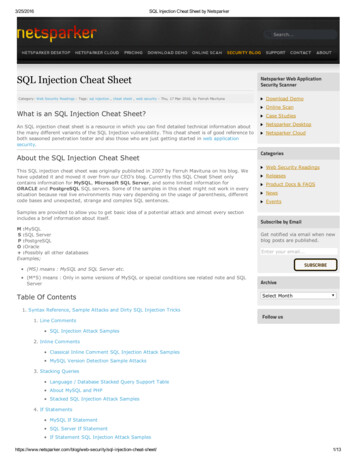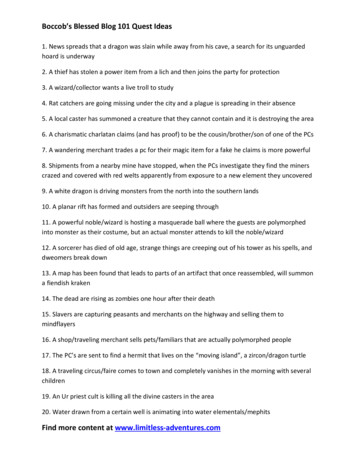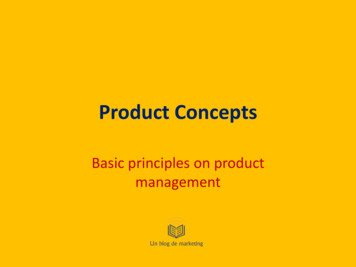
Transcription
Product ConceptsBasic principles on productmanagement
What is a product?Everything, favorable or unfavorable, that a person receives inan exchange, from money.PriceProductisthe “heart” ofMarketingMixPlace (Distribution)Promotion
Classification of Products
Product ClassificationsBusinessProductA product used to manufacture other goods orservices, to facilitate an organization’soperations, or to resell to other consumers.ConsumerProductProduct bought to satisfy an individual’spersonal wants
What kind of products are these?Chapter 9 Version 6e5
Types of consumer UnsoughtProducts
Types of consumer productsConvenienceProductA relatively inexpensive item that merits littleshopping effort.ShoppingProductA product that requires comparison shopping,because it is usually more expensive andfound in fewer stores.SpecialtyProductA particular item that consumers searchextensively for, generally it has no substitutes,and it s available only in specific stores.UnsoughtProductA product unknown to the potential buyer ora known product that the buyer does notactively seek.
Types of consumer products
Product Item,Product Line & Product Mix
What is a Product Item?Product items are various varietiesoffered within a product line, which aresimilar in one or other ways.Such varieties are based on quality, size,color, capacity, price, model,performance, and so on.
Product Line & Product Mix
Example: Gillete Product Line & MixDepth of the product linesWidth of the product mixBlades andrazorsToiletriesMach 3SeriesSensorAdornTrac IIToniAtraRight GuardSwivelSilkienceDouble-EdgeSoft and DriLady GilletteFoamySuper SpeedDry LookTwin InjectorDry IdeaTechmatic Brush PlusWritinginstrumentsLightersPaper MateFlairCricketS.T. Dupont
Benefits of Product LinesAdvertising EconomiesPackage UniformityWhy FormProduct Lines?Standardized ComponentsEfficient Sales andDistributionEquivalent QualityChapter 9 Version 6e13
Importance of Product Lines Diversifies risk Capitalizes on established reputationsImportance of Product Line depth Attracts buyers with different preferences Increases sales/profits by further market segmentation Capitalizes on economies of scale Evens out seasonal sales patterns
Adjustments
AdjustmentsWhat type of Adjustmentscan be made toProduct Items, ProductLines, and MixesProduct LineExtension orContractionProductModificationMarketers must often makeproduct adjustments in orderto keep the productcompetitive and continue toprovide satisfaction to thebuyer.ProductRepositioningThere are risks involved withproduct adjustments: changingthe price of the product mayprice some buyers out, whilechanging the features maydissuade some from continuingto buy the product.
Product ModificationQuality ModificationTypes odification
Examples of Product uresNew ProductDevelopmentValue addedfeatures
Brand Repositioning
Why should we Reposition a brand?A brand needsrepositioning to minimizethe effect of the followingfactorsChangingDemographicsChanges in SocialEnvironmentDecliningSales
Examples of Product RepositioningFlavor Drops to boostDasani bottled waterCheerful designs to repositionSafeskin Sport wrapsRefreshment of Taco Bell Logo to Make the brand More contemporary
Product line Extension or Contraction
Examples of Product Line ExtensionDifferent flavorsand package sizesFor every marketDifferent packages to suit consumption patternsFour different types of productsfor every need
Product Line ContractionSymptoms ofProduct LineOverextension Some products have low sales or cannibalize sales ofother items Resources are disproportionately allocated to slowmoving products Items have become obsolete because of new productentries
The planned obsolescence concept
Planned ObsolescenseThe practice of modifyingproducts so those thathave already been soldbecome obsolete before theyactually need replacement.Cars and electronic devices arethe most representative types ofproducts that practice PO.
Branding
Benefits of BrandingBranding helps todistinguish productsfrom competitionCreates ProductIdentificationLeads to NewProducts SalesGenerateRepeated Sales
What is a brand?A name, term, symbol, design, or combination thereof that identifies a seller’sproducts and differentiates them from competitors’ products.BrandNameThat part of a brand that can be spoken,including letters, words, and numbers.BrandMarkThe elements of a brand that cannot bespoken.BrandEquityThe value of company and brand names.MasterBrandA brand so dominant that it comes tomind immediately when a product category,use, attribute, or benefit is mentioned.
An effective Brand Name Is easy to pronounce Is easy to recognize and remember Is short, distinctive, and unique Describes the product, use, and benefits Has a positive connotation Reinforces the product image Is legally protectable
Master BrandsA brand so dominant that it comes to mind immediately when a product category, use,attribute, or benefit is mentioned. Try to see what are your answers to the following:Energy DrinkRed BullSparkling mineral waterPerrierSmartphoneIphoneA Pick up truckHiluxCanned soupsCampbellsIce CreamCrayonsCola drinkBen & JerrysCrayolaCoca Cola
What is a generic brand?A no-frills, no-brand-name, lowcost product that is simplyidentified by its productcategory.
Branding StrategiesBrandNo ndPrivate ion
Manufacturer s vs Private BrandManufacturers’BrandThe brand name of a manufacturer.PrivateBrandA brand name owned by a wholesaler or aretailer.
Examples ofManufacturer s and Private Brands
Advantages of manufacturer s brands Develop customer loyaltyAttract new customersEnhance prestigeOffer rapid delivery, can carry less inventoryEnsure dealer loyaltyAdvantages of private brands Earn higher profits Less pressure to mark down prices Manufacturer may drop a brand or become a direct competitor todealers No control over distribution of manufacturers’ brands
Individual vs Family brandsIndividualBrandUsing different brand names for differentproducts.FamilyBrandMarketing several differentproducts under the samebrand name.
Examples ofIndividual and Family BrandsDifferent brand names fordifferent category productsAn overall brand name fordifferent category products
Co-BrandingTypes of ooperativeBranding
The end
Marketing several different products under the same brand name. Examples of Individual and Family Brands. Different brand names for different category products An overall brand name for different category products. Co-Branding. Ingredient Branding Cooperative Branding Complementary Branding. Types of Cobrandi
